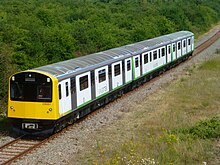
A diesel multiple unit or DMU is a multiple-unit train powered by on-board diesel engines. A DMU requires no separate locomotive, as the engines are incorporated into one or more of the carriages. Diesel-powered single-unit railcars are also generally classed as DMUs. Diesel-powered units may be further classified by their transmission type: diesel–mechanical DMMU, diesel–hydraulic DHMU, or diesel–electric DEMU.
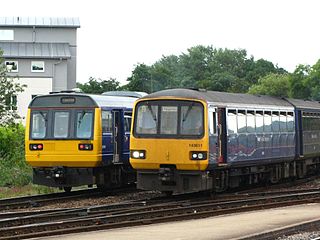
Pacer was the operational name of the British Rail Classes 140, 141, 142, 143 and 144 diesel multiple unit railbuses, built between 1980 and 1987. They were inexpensively developed using a passenger body based on the Leyland National bus on top of a chassis based on the HSFV1 research vehicle. The railbuses were intended as a short-term solution to a shortage of rolling stock, with a lifespan of no more than 20 years. As modernised replacements were lacking, the Pacer fleet remained in service on some lines until 2021 – 37 years after their introduction in 1984.
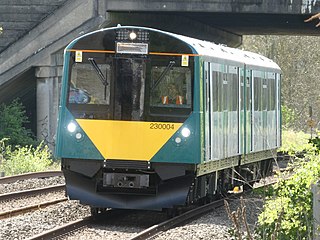
The Marston Vale line is the line between Bletchley and Bedford in England, a surviving remnant of the former Varsity Line between Oxford and Cambridge, most of which was closed in the late 1960s. The line is sponsored by the Marston Vale community rail partnership. The line is to be adopted and upgraded as part of East West Rail, a project underway to re-establish the Oxford–Cambridge route.

The Greenford branch line is a 2 miles 40 chains (4.0 km) Network Rail suburban railway line in west London, England. It runs northerly from a triangular junction with the Great Western Main Line west of West Ealing to a central bay platform at Greenford station, where it has cross-platform interchanges to the London Underground's Central line. A triangular junction near Greenford connects to the Acton–Northolt line. The line serves mainly the suburbs of Ealing and Greenford.
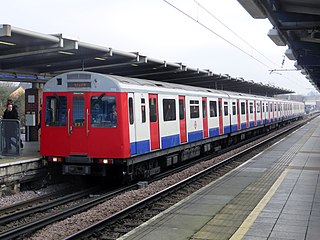
The London Underground D78 Stock, commonly referred to as D Stock, was a type of sub-surface rolling stock which operated on the District line of the London Underground, except on the Wimbledon to Edgware Road service. The first units were withdrawn in January 2015 with the last withdrawn on 21 April 2017.

The British Rail Class 201 six-car diesel-electric multiple units (DEMUs) were built in 1957–1958 at Eastleigh and underframes were built at Ashford.
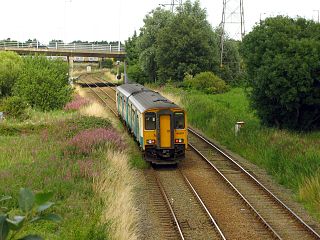
The Borderlands line, also known as the Bidston–Wrexham or Wrexham–Bidston line, is a railway line between Bidston on the Wirral Peninsula in England and Wrexham Central in the north-east of Wales. Passenger train services are part of the Wales & Borders franchise and are operated by Transport for Wales Rail. The line connects to the Merseyrail network at Bidston, the North Wales Coast Line at Shotton and the Shrewsbury–Chester line at Wrexham General. Parts of the line in Wales are used by freight trains, serving Deeside Industrial Park and the Hanson Cement works to the south of Buckley.

The British Rail Class 210 was a type of diesel-electric multiple unit (DEMU) passenger train designed and constructed by British Rail Engineering Limited's Derby Litchurch Lane Works.
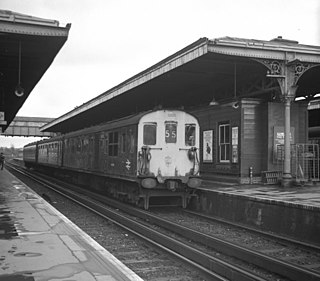
The British Rail Class 206 or 3R was a type of Diesel-electric multiple unit (DEMU), introduced in 1964. They were not 'built' as such but rather re-formed from Class 201 and EPB vehicles for use on Reading-Redhill-Tonbridge services. Six three-car sets were created, numbered 1201-1206.
A hybrid train is a locomotive, railcar or train that uses an onboard rechargeable energy storage system (RESS), placed between the power source and the traction transmission system connected to the wheels. Since most diesel locomotives are diesel-electric, they have all the components of a series hybrid transmission except the storage battery, making this a relatively simple prospect.

A battery electric multiple unit (BEMU), battery electric railcar or accumulator railcar is an electrically driven multiple unit or railcar whose energy is derived from rechargeable batteries driving the traction motors.

Diesel multiple units and railcars are trains, usually with passenger accommodation, that do not require a locomotive. Railcars can be single cars, while in multiple units cars are marshalled together with a driving position either end. As of December 2010, 23 percent of the rail passenger cars used on Network Rail are part of a diesel multiple unit.

Network SouthEast (NSE), the sector of British Rail which ran passenger services in London and southeast England between 1986 and 1994, operated a wide variety of rolling stock during its existence. The majority of the network was electrified, and further electrification schemes took place during the 1986–1994 period; and the 7,000 vehicles owned by NSE in 1986 consisted of a mixture of electric, diesel-electric and diesel multiple units, diesel locomotives and the coaches they hauled.
Vivarail was a British rolling stock manufacturer, founded in 2012 and based in Southam, Warwickshire. Vivarail's main project was the conversion of retired London Underground D78 Stock into two new classes for National Rail services. It was led by former Chiltern Railways chairman Adrian Shooter; the American Railroad Development Corporation was a shareholder.

The British Rail Class 230 D-Train is a diesel electric multiple unit or battery EMU built by rolling stock manufacturer Vivarail for the British rail network. The units are converted from old London Underground D78 Stock, originally manufactured in 1980 by Metro-Cammell, and have been assigned the designation of Class 230 under TOPS.

The British Rail Class 802 is a type of high-speed bi-mode multiple-unit passenger train designed and produced by the Japanese manufacturer Hitachi Rail. It has been operated by Great Western Railway, TransPennine Express, and Hull Trains; each of these train operating companies has given its own units a unique brand: Great Western Railway's units are branded Intercity Express Trains (IETs), TransPennine Express units are branded Nova 1s and Hull Trains' units are branded Paragons.

An electro-diesel multiple unit (EDMU) or bi-mode multiple unit (BMU) is a form of a multiple unit train that can be powered either by electric power picked up from the overhead lines or third rail or by using an onboard diesel engine, driving an electric generator, which produces alternating current (AC) or direct current (DC) electric power.

West Midlands Trains (WMT) is a train operating company in the United Kingdom. It operates passenger trains on the West Midlands franchise between London and the English Midlands under two trading names: within the West Midlands region as West Midlands Railway (WMR) and outside the region as London Northwestern Railway (LNR).
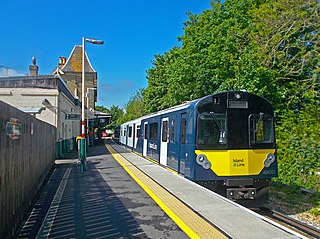
The British Rail Class 484 D-Train is a class of electric multiple unit built by rolling stock manufacturer Vivarail which operates on the Island Line on the Isle of Wight. Based on the British Rail Class 230 diesel multiple unit, the units are part of the Vivarail D-Train family, converted from London Underground D78 Stock originally manufactured in the late 1970s and early 1980s by Metro-Cammell.

Transport for Wales Rail Limited, branded as Transport for Wales and TfW Rail, is a Welsh publicly owned train operating company, a subsidiary of Transport for Wales (TfW), a Welsh Government-owned company. It commenced operations of the day to day services of the Wales & Borders franchise on 7 February 2021, as an operator of last resort, succeeding KeolisAmey Wales.

